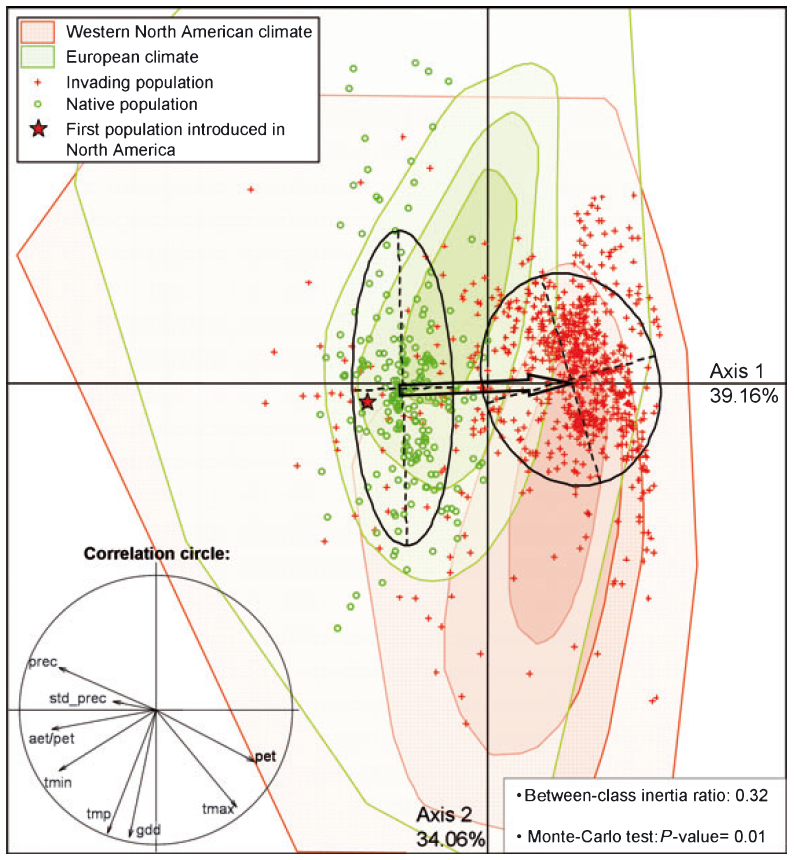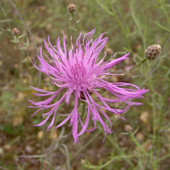Summary
Centaurea is a subproject of the workpackage 3 (WP3.1) of the Project NCCR Plant Survival in Natural and Agricultural Ecosytems which projects ranged from essential research on the physiological processes inside the plants to studies on the plants' interactions within natural and agricultural ecosystems. The aim of WP3 was to understand the spreand and impact of invasive plants. At UNIL, we investigated in particular the invasiveness and ecosystem impact below and above the species level by refining and extending the Centaurea stoebe.
The spotted knapweed, Centaurea stoebe, originates from Europe. It was probably introduced to North America at the end of the 19th century mixed in with alfalfa seeds that were being traded at that time. It has since become an important invasive species in crops causing major financial losses. To biologists, this species represents an ideal model for understanding the causes and consequences of introducing an exotic plant to a region. The establishment and invasive capacities not only depend on the plant's intrinsic traits (morphology, genotype, reproduction method, toxin production,...), but also on the environmental conditions of the area where it is being introduced. Furthermore, they depend on the species' ability to adapt to its new environment such as, for example, the possible consequences of a change in its ecological niche. Studying invasive plants in both their place of origin and in the invaded area is necessary in order to determine which biological factors and which environmental changes could have contributed to their successful proliferation. We could then better predict the future distribution of these plants in their new environment.
Publications
Broennimann O., Mráz P., Petitpierre B., Guisan A., Müller-Schärer H., 2014. Contrasting spatio-temporal climatic niche dynamics during the eastern and western invasions of spotted knapweed in North America. Journal of Biogeography 41 pp. 1126-1136
Guisan A., Petitpierre B., Broennimann O., Daehler C., Kueffer C., 2014. Unifying niche shift studies: insights from biological invasions. Trends in Ecology and Evolution 29(5) pp. 260-269
Broennimann O., Fitzpatrick M.C., Pearman P.B., Petitpierre B., Pellissier L., Yoccoz N.G., Thuiller W., Fortin M.J., Randin C.R., Zimmermann N.E. et al., 2012. Measuring ecological niche overlap from occurrence and spatial environmental data
Hordijk W., Broennimann O., 2012. Dispersal routes reconstruction and the minimum cost arborescence problem. Journal of Theoretical Biology 308 pp. 115-122
Mráz P., Spaniel S., Keller A., Bowmann G., Farkas A., Singliarová B., Rohr R.P., Broennimann O., Müller-Schärer H., 2012. Anthropogenic disturbance as a driver of microspatial and microhabitat segregation of cytotypes of Centaurea stoebe and cytotype interactions in secondary contact zones. Annals of Botany 110(3) pp. 615-627
Treier U.A., Broennimann O., Normand S., Guisan A., Schaffner U., Steinger T., Müller-Schärer H., 2009. Shift in cytotype frequency and niche space in the invasive plant Centaurea maculosa. Ecology 90(5) pp. 1366-1377
Broennimann O., Guisan A., 2008. Predicting current and future biological invasions: both native and invaded ranges matter. Biology Letters 4(5) pp. 585-589
Broennimann O., Treier U. A., Muller-Scharer H., Thuiller W., Peterson A. T., Guisan A., 2007. Evidence of climatic niche shift during biological invasion. Ecology Letters 10(8) pp. 701-709


